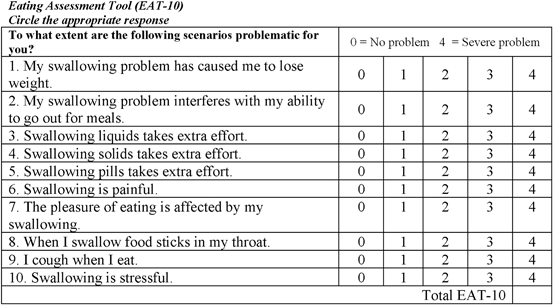
OD causes respiratory infections including aspiration pneumonia, which leads to mortality in up to 50%. It is highly prevalent among several underlying pathologies and varies according to the severity of the concomitant disease, affecting up to 27% of community-dwelling older adults, over 50% of hospitalized or institutionalized older patients, 50% of stroke patients, from 24% to 86% of patients with neurodegenerative diseases, and from 17% to 86% of patients with head and neck structural disorders. Oropharyngeal dysphagia (OD) is a condition recognized by the World Health Organization (WHO), classified in the International Statistical Classification of Diseases and Related Health Problems with the codes ICD-9: 787.2 and ICD-10: R13. Our results support its utility in the screening and clinical diagnosis and management of OD.

(4) Conclusions: The V-VST has strong psychometric properties and valid endpoints for OD in different phenotypes of patients. They indicated that V-VST has been used internationally to assess OD’s prevalence and complications. Quality of studies in SR was graded as high with low risk of bias. Likelihood ratios (LHR) for OD were 0.08 (LHR–) and 5.01 (LHR+), and the diagnostic odds ratio for OD was 51.18. V-VST had a diagnostic sensitivity for OD of 93.17%, 81.39% specificity, and an inter-rater reliability Kappa = 0.77. (3) Results: For the diagnostic accuracy SR: four studies were included. The SR protocol was registered on PROSPERO (registration: CRD42020136252). Quality of studies was assessed by Dutch Cochrane, QUADAS, GRADE (SR), and STROBE (ScR) criteria. A meta-analysis was done in the SR to assess the psychometric properties of the V-VST. Searches were done in different databases, including PubMed and EMBASE from September 2008 until May 2020, and no language restrictions were applied.

(2) Methods: We performed both a systematic review (SR) including studies that look at the diagnostic test accuracy, and a scoping review (ScR) with articles published from September 2008 to May 2020. Our aims were to examine the clinical utility of the V-VST against videofluoroscopy (VFS) or fiberoptic endoscopic evaluation of swallow (FEES) and to map the V-VST usage with patients at risk of OD across the years since it was described for the first time, carrying a systematic and a scoping review. (1) Background: The volume-viscosity swallow test (V-VST) is a clinical tool for screening and diagnosis of oropharyngeal dysphagia (OD).


 0 kommentar(er)
0 kommentar(er)
